 |
|
|
“When I was a kid I liked fall best.
Spring and summer were frivolous, made for children and tourists. Autumn was serious, solemn, mature. . . . The season clarified me. I savored its bittersweet tang.” |
|
Mums are finicky about when they choose to bloom. At the entrance to the Garden are dozens of plants bristling with fat, full buds. They have been there bristling and fat-budded for four weeks. I thought that surely they would be in bloom this week since the first frost is only two weeks off. They weren't. I'm sure the keepers of the Garden are exasperated since the mums will soon have to be replaced by spring bulbs and pansies. If the folks who run this place have trouble picking budded mums that will open when they ought to, I think I will buy only mums already in flower. 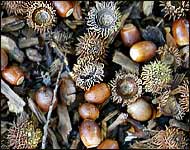 Several weeks ago I thought that when the mop-top acorns of the sawtooth oaks that border the entry plaza fell, they would become favorite souvenirs of garden visitors. The acorns are now falling but their tops pop off when they hit the ground. Now the ground is littered with acorn parts that don't fit. Inside of being pocketed, these "some assembled required" acorns are kicked aside or ignored by most passerbys. Several weeks ago I thought that when the mop-top acorns of the sawtooth oaks that border the entry plaza fell, they would become favorite souvenirs of garden visitors. The acorns are now falling but their tops pop off when they hit the ground. Now the ground is littered with acorn parts that don't fit. Inside of being pocketed, these "some assembled required" acorns are kicked aside or ignored by most passerbys. In this latitude the semi-tropical Violet Trumpet Vine is supposed to grow inside. Shielded by the glass panes of the Linnean Greenhouse the vine has grown vigorously for many years. In winter the vine presses to the glass so closely that its leaves often wilt and brown from the cold. This morning I noticed that the vine had somehow found or made a hole in the gable of the Linnean greenhouse and escaped. It dangles like the end of a boa from the base of the plinth that supports a bust of the ever stoic Linneaus. In this latitude the semi-tropical Violet Trumpet Vine is supposed to grow inside. Shielded by the glass panes of the Linnean Greenhouse the vine has grown vigorously for many years. In winter the vine presses to the glass so closely that its leaves often wilt and brown from the cold. This morning I noticed that the vine had somehow found or made a hole in the gable of the Linnean greenhouse and escaped. It dangles like the end of a boa from the base of the plinth that supports a bust of the ever stoic Linneaus.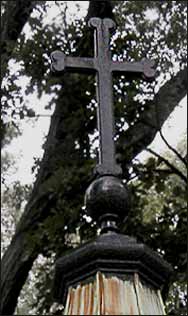 More than a century ago Henry Shaw built a granite mausoleum for himself so that he would never have to leave the Garden. His mausoleum is topped with a Christian cross. Curiously, the arms of the cross do not end in angles, but in curves. The ends of the arms bulge to form two rounded knobs that fold in on themselves like the fists of two hands touching. Shaw was a classicist, so I am sure the cross he chose was a considered decision with some symbolic meaning. But, after thumbing through books on crosses and Christian symbolism for a couple of pleasant hours in the library of a school of theology, I still don't know what Shaw's cross means. More than a century ago Henry Shaw built a granite mausoleum for himself so that he would never have to leave the Garden. His mausoleum is topped with a Christian cross. Curiously, the arms of the cross do not end in angles, but in curves. The ends of the arms bulge to form two rounded knobs that fold in on themselves like the fists of two hands touching. Shaw was a classicist, so I am sure the cross he chose was a considered decision with some symbolic meaning. But, after thumbing through books on crosses and Christian symbolism for a couple of pleasant hours in the library of a school of theology, I still don't know what Shaw's cross means.I did learn that the ends of the arms of crosses were shaped into hundreds of forms. They were often used as the insignia of a family or clan. They were like the unique pattern of a kilt, the design of a coat of arms or battle flag, or the insignia on a ring. In a time when few could read, these symbols stood for people of power and influence. In every book I found references to the cross of botany - the "budded cross." It is a trefoil cross - two rounded ends that like sepals protect a protruding bud in the center. The cross symbolizes life, growth, and renewal. Its arms that end in three symbolize the Trinity. I found only a passing reference to a cross with arms that curved into two rounded ends. The cross is called the Cross Recercellée. That's all. The cross has a name but nothing more was said in any of the books. But why the name? What does it mean? Why did Shaw pick it instead of the more logical choice: the budded cross? I'm at a dead-end. Last week the sun-washed east wall of Shaw's house was dotted with medium-sized butterflies that at first-glance looked like small monarchs. But, their markings were too haphazard and irregular to be monarchs, and they had puddles of white near the tips of their wings. I matched what I saw with the pictures in a book on butterflies. They are "Painted Ladies" the book said, and they live in more places on earth than any other butterfly. 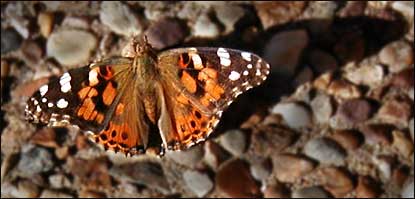 A couple of days ago a piece in the St. Louis Post-Dispatch said that the buttery-copper Painted Ladies I saw have fluttered into the whole Midwest in records numbers. In Chicago, they talk of a "butterfly blizzard." In Iowa, they say they've "swarmed into alfalfa fields by the thousands to sip from blossoms." The collections manager of the Garden's Butterfly House says that no one knows why so many Painted Ladies are here this year. He speculates, "There's probably all sorts of environmental factors that could have played into this. Perhaps there were fewer predators, or fewer painted lady larvae were beaten down by rainstorms." I looked for the Ladies again this week. They are still here in numbers: especially on the salvia and on sun-warmed walls and surfaced walkways. I found this one on the pebbled walk in the boxwood garden. A hummingbird perused and attacked a monarch butterfly high over a patch of flowers they both favored. Neither was injured. 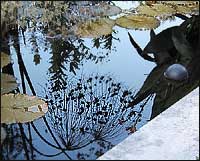 Steam rises from the movement of water in the fountains and collects in puddles. In pools where the water is still, the reflection of the plants on the surface is bright and undistorted. The hard morning light and the intense blue sky sharpen the edges of the leaves and stems outlined on the water. The reflection of an arching umbrella-cluster of a papyrus plant potted in the middle of one of the ponds is like a starburst of fireworks.
Steam rises from the movement of water in the fountains and collects in puddles. In pools where the water is still, the reflection of the plants on the surface is bright and undistorted. The hard morning light and the intense blue sky sharpen the edges of the leaves and stems outlined on the water. The reflection of an arching umbrella-cluster of a papyrus plant potted in the middle of one of the ponds is like a starburst of fireworks.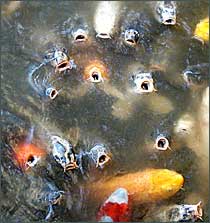 I went to a baseball game this week. From seats in the upper deck, I was close enough to watch as foul balls headed toward the lower level. A foul ball always meant a scramble to see who would the lucky one to take it home. Whenever a ball approached, a knot of fans would gather at the point they figured the ball would land, nudging and shoving each other to get into the sweet spot. This morning Pat threw some pellets of fish food to the koi. Heads up. I went to a baseball game this week. From seats in the upper deck, I was close enough to watch as foul balls headed toward the lower level. A foul ball always meant a scramble to see who would the lucky one to take it home. Whenever a ball approached, a knot of fans would gather at the point they figured the ball would land, nudging and shoving each other to get into the sweet spot. This morning Pat threw some pellets of fish food to the koi. Heads up.Just a month ago, the ducks looked dull and disheveled. Molting, I guess. This morning we saw a row of five wood ducks perched at the edge of the water. They had been transformed. Markings were crisp; colors were deep and pure. Feathers were sleek and held close to their bodies. These are the ducks that will bring colors of festival to the grays and browns of the coming winter. Dozens of swifts were sky diving at the west end of the lake in the Japanese Garden. Occasionally, one would skim the surface of the lake and then veer up as though not cleared for landing. I never saw any of the birds land. Hummingbirds, especially in the fall, do feed and then perch. Swifts never seem to touch down. I had never seen so many swifts romping around the same piece of sky so I checked web to find out why. The Missouri Conservationist says that what I saw was a family group of chimney swifts. This family will join other families to make a flock of thousands that will migrate to Peru for the winter. Odd seeing swifts today just after reading a vignette about swifts written by the 18th century naturalist Gilbert White. He claims that because he was the first to "regard these birds with no small attention" he discovered that swifts "tread, or copulate, on the wing: and I would wish any nice observer, that is startled by this supposition, to use his own eyes, and I think he will soon be convinced." White observed that the "amorous act" took place in the May as one bird landed on the back of another and then with loud shrieking calls, they dropped as if hitting an air pocket. "This," he wrote, "I take to be the juncture when the business of generation is carrying on." The delicate language of Gilbert White and the grace of swifts in air fit so well together. Add another tree to my "worried about" list. Last week it was a crab. There are many crabapples in the Garden, but only two Flowering Apricot 'Peggy Clarke.' They are special because they bring pink blossoms to any lull in late winter. It is not unusual to see their pink flowers open when the daffodil leaves are just poking through their bed of mulch. Most of the leaves of the 'Peggy Clarke' planted in front of the wall of the education building of the Climatron are curling and drying. Too soon for fall and unlikely because of lack of water. Losing this tree means losing the first inklings of spring. Let it live. 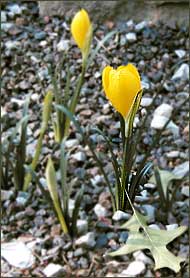 Autumn daffodil (Sternbergia sicola) the sign says. The flower, as yellow as a daffodil with the spear leaves of a daffodil is poking out of the limestone cover in the rock garden. Unlike a daffodil though the flower seems to open and close with the sun much like the goblets of crocus blooms. And sources I looked at say that the open flower resembles a daylily more than it does a daffodil. Technically, the flower is an amaryllis but I think that fact ought to be kept under wraps. Calling it an Autumn Daffodil makes an ordinary flower special.
Autumn daffodil (Sternbergia sicola) the sign says. The flower, as yellow as a daffodil with the spear leaves of a daffodil is poking out of the limestone cover in the rock garden. Unlike a daffodil though the flower seems to open and close with the sun much like the goblets of crocus blooms. And sources I looked at say that the open flower resembles a daylily more than it does a daffodil. Technically, the flower is an amaryllis but I think that fact ought to be kept under wraps. Calling it an Autumn Daffodil makes an ordinary flower special.Mosquitoes everywhere. Thick jeans protect my legs; a light jacket over my tee shirt takes care of my arms. Undeterred, the bugs go for my face. Three landed on my cheeks before the palm of my hand landed on them. The mums are here. The lush, overgrown displays of summer have been ripped out to make room for what are sure to be yellow, rust, and salmon mums when their buds open. Many of the tight-budded plants were put in a week ago. By next week, they ought to begin to show. For most of the year, hummingbirds are elusive. Seeing a bird is mostly a matter of chance. September though is different. With so many migrating birds stopping in the Garden on their way South, a sighting is certain anywhere that salvia grows. The birds avoid the varieties with dense stocks of flowers and head instead to types that widely space their tubular flowers along their stems. There is a patch of intensely blue salvia (Salvia guaranitica) in the bulb garden that they especially like. Perhaps it's because they can shuttle between mining the flowers and perching on a nearby Hawthorne tree. In that one patch of salvia, I saw six birds in about five minutes. I took several pictures, all of which show blurs or tiny dots that only I would recognize as a hummingbird. 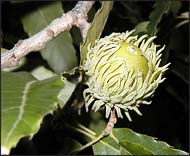 The sawtooth oaks (Quercus acutissima) that border the fountain in the entry plaza are brimming with acorns. The acorns are fully-grown, but still are green. Unlike the sleek, no nonsense acorns of most of the street oaks I usually see, the cloche-like caps of sawtooth oak acorns envelope the nuts with a tangled mop of stringy fibers. When the nuts brown and drop in a few weeks, they are sure to become souvenirs for many Garden visitors despite a caution in a new Garden guide urging strollers to leave with empty hands and pockets. The sawtooth oaks (Quercus acutissima) that border the fountain in the entry plaza are brimming with acorns. The acorns are fully-grown, but still are green. Unlike the sleek, no nonsense acorns of most of the street oaks I usually see, the cloche-like caps of sawtooth oak acorns envelope the nuts with a tangled mop of stringy fibers. When the nuts brown and drop in a few weeks, they are sure to become souvenirs for many Garden visitors despite a caution in a new Garden guide urging strollers to leave with empty hands and pockets. Until this morning I had never seen a crab apple bloom in the fall. I followed a hummingbird to an old crab apple tree in the bulb garden and saw the bird hover beside a patch of pink. When the bird lost interest, I moved closer. The tree was speckled with tufts of pink-white blooms. Unlike other nearby trees, this crab had few fruit and even fewer leaves. Perhaps the aged tree will die before the other crabs bloom again. So it blooms now, one last time. Until this morning I had never seen a crab apple bloom in the fall. I followed a hummingbird to an old crab apple tree in the bulb garden and saw the bird hover beside a patch of pink. When the bird lost interest, I moved closer. The tree was speckled with tufts of pink-white blooms. Unlike other nearby trees, this crab had few fruit and even fewer leaves. Perhaps the aged tree will die before the other crabs bloom again. So it blooms now, one last time.Twice in widely separated parts of the Garden I saw a shrub that I had never seen before. Along the garden wall behind the daylily garden, the small shrub was blooming in a shady spot among a collection of honeysuckle. The shrub had no identifying label. Learning from a nearby sign about honeysuckle, I guessed that the shrub was a part of a family that included honeysuckle and viburnum. To be part of the clan, a plant had to arrange its leaves so that they were across from one another and it had to have all of its flower parts attached to the top of its ovary - "a small green egg or ball." I checked the unknown shrub - Yes on both counts. It belonged. 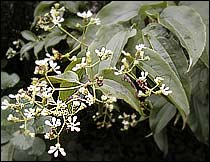 The second time I saw the shrub I was looking at an ornamental peach along a wall at the edge of the vegetable garden. Glancing to my left, I saw the same shrub. Now planted in full sun it had morphed into a small tree. It was bristling with creamy white flower spikes and was labeled Heptacodium miconioides. When I got home I did some checking. The second time I saw the shrub I was looking at an ornamental peach along a wall at the edge of the vegetable garden. Glancing to my left, I saw the same shrub. Now planted in full sun it had morphed into a small tree. It was bristling with creamy white flower spikes and was labeled Heptacodium miconioides. When I got home I did some checking.Heptacodium, also known as the seven-son flower, arranges its flowers in clusters of seven. As one source put it, "Although its name may be slightly unattractive, it has all the ornamental features necessary to be a prized, useful, and well accepted landscape plant." What excites growers about Heptocodium is that it is a three-act plant. It opens in late summer with plentiful, long-lasting, fragrant flowers. When the flowers fade, the seedpods and sepals turn maroon so that the shrub looks as though it is blooming again right into November. Then for its finale, Heptocodium stripes off ribbons of its bark in winter. Now that the drama has begun, I can hardly wait for Acts II and III. 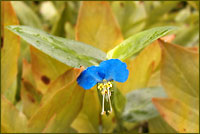 I was on the grass looking at an Amur Cork tree when a brown hawk flew no more than ten feet over the asphalt garden path in front of me and then veered off into a grove of holly trees. I thought of that hawk when I saw a couple of fugitive dayflowers (Commelina communis) growing up through the strip of peonies in the Japanese Garden. Dayflowers are rare in this Garden. Keepers seem think of them as described in an extension bulletin "a pretty weed that can quickly take over a garden" and so prefer to pull them, not encourage them. The peony leaves hid most of the foliage of the dayflower I spotted. Left only was a flower in flight. I was on the grass looking at an Amur Cork tree when a brown hawk flew no more than ten feet over the asphalt garden path in front of me and then veered off into a grove of holly trees. I thought of that hawk when I saw a couple of fugitive dayflowers (Commelina communis) growing up through the strip of peonies in the Japanese Garden. Dayflowers are rare in this Garden. Keepers seem think of them as described in an extension bulletin "a pretty weed that can quickly take over a garden" and so prefer to pull them, not encourage them. The peony leaves hid most of the foliage of the dayflower I spotted. Left only was a flower in flight. |
|